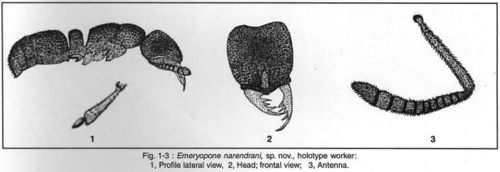Emeryopone narendrani
| Emeryopone narendrani | |
|---|---|

| |
| Scientific classification | |
| Kingdom: | Animalia |
| Phylum: | Arthropoda |
| Class: | Insecta |
| Order: | Hymenoptera |
| Family: | Formicidae |
| Subfamily: | Ponerinae |
| Tribe: | Ponerini |
| Genus: | Emeryopone |
| Species: | E. narendrani |
| Binomial name | |
| Emeryopone narendrani Varghese, 2006 | |
Nothing is known about the biology of Emeryopone narendrani.
Identification
Varghese (2006) - The new species, E. narendrani resembles Emeryopone buttelreepeni in having similar colour, antennomere, and petiolar width, but differs from E. buttelreepeni in being of smaller size (E. buttelreepeni: 4.00-4.50 mm, E. narendrani: 3.80 mm), having smaller eyes, which are placed well anteriorly, and by the nature of the subpetiolar process. It differs clearly from Emeryopone loebli (3.2 mm) in having brown color and being larger in size. It differs mainly from Emeryopone franzi (4.5 mm) in being of smaller size, having very small eyes, by the nature of the petiole and the subpetiolar process. The new species, E. narendrani differs noticeably from Emeryopone melaina (4.9 mm) in being much smaller in size and by having very small eyes. Other differences in body parameters are given in figure 4, along with those of other species given in Baroni Urbani (1975) and Xu (1998) for comparison.
Keys including this Species
Distribution
Latitudinal Distribution Pattern
Latitudinal Range: 14.43333333° to 14.43333333°.
| North Temperate |
North Subtropical |
Tropical | South Subtropical |
South Temperate |
- Source: AntMaps
Distribution based on Regional Taxon Lists
Oriental Region: India (type locality).
Distribution based on AntMaps
Distribution based on AntWeb specimens
Check data from AntWeb
Countries Occupied
| Number of countries occupied by this species based on AntWiki Regional Taxon Lists. In general, fewer countries occupied indicates a narrower range, while more countries indicates a more widespread species. |

|
Estimated Abundance
| Relative abundance based on number of AntMaps records per species (this species within the purple bar). Fewer records (to the left) indicates a less abundant/encountered species while more records (to the right) indicates more abundant/encountered species. |

|
Biology
Castes
Nomenclature
The following information is derived from Barry Bolton's Online Catalogue of the Ants of the World.
- narendrani. Emeryopone narendrani Varghese, 2006b: 90, figs. 1-3 (w.) INDIA.
Type Material
- Holotype, worker, Karnataka: Utttara Kannada, Kumta, India, 14°26′0″N 74°27′0″E / 14.433333°N 74.45°E, May 1998, H.M. Ganapathy, Insect Museum at the Centre for Ecological Sciences.
Unless otherwise noted the text for the remainder of this section is reported from the publication that includes the original description.
Description
Worker
Total length 3.8mm, head longer than broad (CI 0.86mm), slightly broader posteriorly than anteriorly, with almost straight cheeks, posterior corners rounded, posteriorly broadly emarginated. Mandibles elongate-triangular, broadly curved with long, slender spiniform teeth, apical tooth very long, third one smallest. Clypeus broadly convex, depressed towards sides and projects like convex cuticular lobes laterally. Frontal area distinct, with short frontal lobes. Antennae 12 segmented, funicular segments gradually thickening towards apex with 3 segmented club, the ultimate antennomere more than 2x longer than broad (ANTML 0.32 mm, ANTMW 0.14 mm, ANTMI 0.43 mm), scape long (SL 0.68 mm), but not reaching beyond head. Eyes very small (EL 0.05 mm), and placed towards the anterior lateral corners of head, more towards the base of mandibles. Thorax broad, not broader than head, broader than long and broader than mesonotum and metanotum, pronotum anteriorley rounded, promesonotal suture distinct, meso-metanotal suture obsolete. Propodeum with a posterior concave declivity. Petiole broader than long (PTI 1.22 mm), with well formed subpetiolar process. Legs short and stouter, hind leg with a single pectinate spur. Gaster long and rounded posteriorly.
Head, thorax, petiole and gaster foveate, interfoveal space more or less smooth and shining, mandibles smooth and shining, clypeus sculptured, propodeal concavity longitudinally striated, legs smooth and shining. Body hairs sub recumbent, short and abundant. Head, thorax, petiole and gaster ferruginous, mandibles, antennae, legs and extreme tip of gaster lighter.
Etymology
This species is named after my beloved teacher, Professor Narendran Te, University of Cali cut, India, who trained me in the fundamentals of taxonomy.
References
References based on Global Ant Biodiversity Informatics
- Varghese T. 2006. Description of a new species of the ponerine ant genus, Emeryopone (Hymenoptera: Formicidae) from Karnataka, India. Biospectra 1: 89-92.
